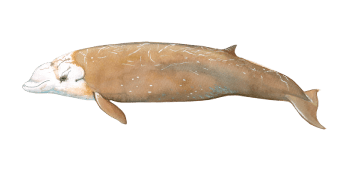
Cuvier’s beaked whale
(Ziphius cavirostris)
Cuvier’s beaked whales are widely distributed and appear in all the world’s oceans. Like other beaked whale species they prefer deep waters and are, according to current knowledge, the deepest living mammals.
The deepest documented dive was almost 3000m deep. Like most beaked whales, they are suction feeders and hunt for deep-sea squid and mesopelagic fish in the dark ocean, diving at a velocity of 100 m per minute. Observations usually involve solitary animals or groups of up to seven individuals.
They can be distinguished from other beaked whale species through their comparably robust build and relatively short beak. Adult males have two visible teeth at the end of their lower jaw which is curved slightly upwards, giving the appearance of a smile”
The body colouration varies from dark grey to rusty-brown with a much paler head that can almost appear as white.
General information
Further names: Portuguese: Baleia-de-bico-de-Cuvier, Zifio; English: Goosebeak whale
Size of adults: 6,90 m (males); 5,50 m (females)
Prey: Squid, fish, crustaceans
Behaviour: Little knowledge about their social behaviour. They occur in small groups and sightings are usually very brief. Can be quite active at the surface engaging in impressive breaches.
Range: In deep waters worldwide (excluding polar regions); prefers deep seas
Madeira: Occasionally encountered in the summer
Distinctive features: Pale or almost white head coloration and a distinctive “dip” between melon and back. Their relatively tiny and triangular dorsal fin is set further towards their flukes.
Taxonomy: Suborder: Odontoceti (Toothed Whales); Family: Ziphiidae (Beaked Whales)
Threats: Are victims of bycatch in fishing gear (mainly deepwater-driftnets) and of naval military excercises and seismic drilling, noise pollution that causes panic resulting in decompression illness, acoustic trauma and embolism. Are listed as least concern by the IUCN, global populations are estimated to a total of 100,000 animals).
